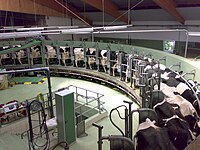
Photo from wikipedia
Sensor data from automation are becoming available on an increasingly large scale, and associated research is slowly starting to appear. This new era of sensor data from automation leads to… Click to show full abstract
Sensor data from automation are becoming available on an increasingly large scale, and associated research is slowly starting to appear. This new era of sensor data from automation leads to many challenges but also new opportunities for assessing and maximizing the genetic potential of dairy cattle. The first challenge is data quality, because all uses of sensor data require careful data quality validation, potentially using external references. The second issue is data accessibility. Indeed, sensor data generated from automation are often designed to be available on-farm in a given system. However, to make these data useful-for genetic improvement for example-the data must also be made available off-farm. By nature, sensor data often are very complex and diverse; therefore, a data consolidation and integration layer is required. Moreover, the traits we want to select have to be defined precisely when generated from these raw data. This approach is obviously also beneficial to limit the challenge of extremely high data volumes generated by sensors. An additional challenge is that sensors will always be deployed in a context of herd management; therefore, any efforts to make them useful should focus on both breeding and management. However, this challenge also leads to opportunities to use genomic predictions based on these novel data for breeding and management. Access to relevant phenotypes is crucial for every genomic evaluation system. The automatic generation of training data, on both the phenotypic and genomic levels, is a major opportunity to access novel, precise, continuously updated, and relevant data. If the challenges of bidirectional data transfer between farms and external databases can be solved, new opportunities for continuous genomic evaluations integrating genotypes and the most current local phenotypes can be expected to appear. Novel concepts such as federated learning may help to limit exchange of raw data and, therefore, data ownership issues, which is another important element limiting access to sensor data. Accurate genome-guided decision-making and genome-guided management of dairy cattle should be the ultimate way to add value to sensor data from automation. This could also be the major driving force to improve the cost-benefit relationship for sensor-based technologies, which is currently one of the major obstacles for large-scale use of available technologies.
Journal Title: Journal of dairy science
Year Published: 2019
Link to full text (if available)
Share on Social Media: Sign Up to like & get
recommendations!